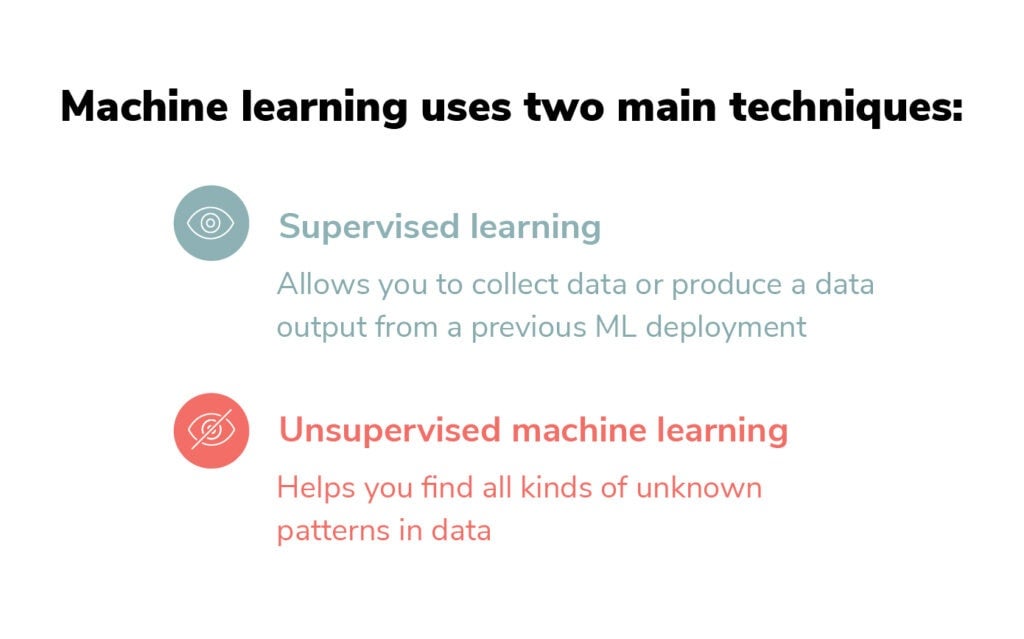This article was originally published at Algorithimia’s website. The company was acquired by DataRobot in 2021. This article may not be entirely up-to-date or refer to products and offerings no longer in existence.
How machine learning works
The early stages of machine learning (ML) saw experiments involving theories of computers recognizing patterns in data and learning from them. Today, after building upon those foundational experiments, machine learning is more complex.
While machine learning algorithms have been around for a long time, the ability to apply complex algorithms to big data applications more rapidly and effectively is a more recent development. Being able to do these things with some degree of sophistication can set a company ahead of its competitors.
How does machine learning work?
Machine learning is a form of artificial intelligence (AI) that teaches computers to think in a similar way to how humans do: Learning and improving upon past experiences. It works by exploring data and identifying patterns, and involves minimal human intervention.
Almost any task that can be completed with a data-defined pattern or set of rules can be automated with machine learning. This allows companies to transform processes that were previously only possible for humans to perform—think responding to customer service calls, bookkeeping, and reviewing resumes.

Machine learning uses two main techniques:
- Supervised learning allows you to collect data or produce a data output from a previous ML deployment. Supervised learning is exciting because it works in much the same way humans actually learn.
In supervised tasks, we present the computer with a collection of labeled data points called a training set (for example a set of readouts from a system of train terminals and markers where they had delays in the last three months).
- Unsupervised machine learning helps you find all kinds of unknown patterns in data. In unsupervised learning, the algorithm tries to learn some inherent structure to the data with only unlabeled examples. Two common unsupervised learning tasks are clustering and dimensionality reduction.
In clustering, we attempt to group data points into meaningful clusters such that elements within a given cluster are similar to each other but dissimilar to those from other clusters. Clustering is useful for tasks such as market segmentation.
Dimension reduction models reduce the number of variables in a dataset by grouping similar or correlated attributes for better interpretation (and more effective model training).
How is machine learning used?
From automating tedious manual data entry, to more complex use cases like insurance risk assessments or fraud detection, machine learning has many applications, including client-facing functions like customer service, product recommendations (see Amazon product suggestions or Spotify’s playlisting algorithms), and internal applications inside organizations to help speed up processes and reduce manual workloads.
A major part of what makes machine learning so valuable is its ability to detect what the human eye misses. Machine learning models are able to catch complex patterns that would have been overlooked during human analysis.
Thanks to cognitive technology like natural language processing, machine vision, and deep learning, machine learning is freeing up human workers to focus on tasks like product innovation and perfecting service quality and efficiency.
You might be good at sifting through a massive but organized spreadsheet and identifying a pattern, but thanks to machine learning and artificial intelligence, algorithms can examine much larger sets of data and understand patterns much more quickly.

What is the best programming language for machine learning?
Most data scientists are at least familiar with how R and Python programming languages are used for machine learning, but of course, there are plenty of other language possibilities as well, depending on the type of model or project needs. Machine learning and AI tools are often software libraries, toolkits, or suites that aid in executing tasks. However, because of its widespread support and multitude of libraries to choose from, Python is considered the most popular programming language for machine learning.
In fact, according to GitHub, Python is number one on the list of the top machine learning languages on their site. Python is often used for data mining and data analysis and supports the implementation of a wide range of machine learning models and algorithms.
Supported algorithms in Python include classification, regression, clustering, and dimensionality reduction. Though Python is the leading language in machine learning, there are several others that are very popular. Because some ML applications use models written in different languages, tools like machine learning operations (MLOps) can be particularly helpful.
Get Started Today.